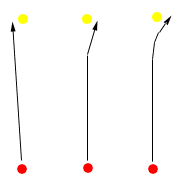
|
Back to |
| The Front Page |
| The Game |
|
Coaching the Fundamentals of the Stroke Part Three: Why Do I Miss? by John Riches, Australian Correspondent Posted August 27, 1997
|
| |||||||
It's the despairing cry of every serious player who has found that practice does not always make perfect. But no amount of training will increase your roquet percentage until you or your coach can find out how your stance, your grip, and your body movements are affecting the accuracy of your stroke.
Why do I miss my roquets? There are many possible answers to this question, but players and coaches are often unaware that some clues can be gained by observing the path of the ball.
Diagram "A" shows the striker's ball traveling in a straight line but missing the target ball on the left hand side. This means, of course, that the ball was simply hit in the wrong direction - but why? Assuming that the body was correctly positioned after stalking the ball to get hips and shoulders square, and there was no unnecessary body movement during the swing, the most common cause is that the grip was tightened just before the mallet contacted the ball, destroying the straight alignment of the mallet. This is most likely to happen in tense situations when the player finds it difficult to relax during the swing. The coach cannot actually see the tightening occurring, but a further clue is that the forward swing will almost always be hurried rather than "letting the mallet do the work", and the backswing will often have been shortened.

To overcome this problem, the player must be taught not to tighten his grip during the swing. A competent, accredited coach should know how to go about training the player to achieve a relaxed, smooth swing with an even grip tension throughout.
In Diagram "B" the miss was not the fault of the player at all - it was caused by the ball hitting something on the lawn which caused the path of the ball to bend noticeably at one particular point. All you can do is congratulate yourself on a good, straight hit...and blame the greens keeper!
Diagram "C" shows the ball taking a curved path and missing the target ball on the right hand side (for a right-handed player). This suggests that the player has "sliced" the shot, by swinging (or rather, "pushing" with the bottom hand) his mallet across the line of aim. He may need to get his bottom hand more directly behind the shaft, use a straighter backswing (this also needs correct training, and may require adjustment to foot and body positions), play the stroke more with his top hand instead of his bottom hand, and concentrate on following through long and low along the line of aim.
These observations should provide clues to the cause of the miss, but only good coaching and diligent, well-planned practice sessions will correct it.
E-Mail: John.Riches@Adelaide.on.net